 ALADDIN An imprint of Simon & Schuster Childrens Publishing Division 1230 Avenue of the Americas, New York, NY 10020 Copyright 2008 by David Colbert All rights reserved, including the right of reproduction in whole or in part in any form. ALADDIN and related logo are registered trademarks of Simon & Schuster, Inc. Special thanks to Paul Gasbarra and Jesse Waters for their significant contributions to this book, and to John Chew for his mathematical expertise. Library of Congress Control Number 2008920646 ISBN-13: 978-1-4169-9890-7 ISBN-10: 1-4169-9890-X
ALADDIN An imprint of Simon & Schuster Childrens Publishing Division 1230 Avenue of the Americas, New York, NY 10020 Copyright 2008 by David Colbert All rights reserved, including the right of reproduction in whole or in part in any form. ALADDIN and related logo are registered trademarks of Simon & Schuster, Inc. Special thanks to Paul Gasbarra and Jesse Waters for their significant contributions to this book, and to John Chew for his mathematical expertise. Library of Congress Control Number 2008920646 ISBN-13: 978-1-4169-9890-7 ISBN-10: 1-4169-9890-X
Visit us on the Web:
http://www.SimonandSchuster.com
CONTENTS

Although a child of the nineteenth century, Thomas Edisons interests and inventions parallel some of the most popular technologies of the Internet Age.

DAY 1:
FALL, 1862
BUILT FOR SPEED
A heroic moment leads to unexpected good fortune and a lifelong friendship.

DAY 2:
JANUARY 30, 1869
NETWORKING
An ambitious vagabond stops jumping around the country and takes a true leap of faith.

DAY 3:
DECEMBER 30, 1874
ALL THAT GLITTERS
High finance meets technology when Edison creates a revolutionary communications tool.

DAY 4:
MARCH 28, 1876
MENLO PARK
Edison creates an idea factory where he and his assistants can invent without restraint.

DAY 5:
NOVEMBER 29, 1877
CLEAR AS A BELL
Alexander Graham Bells good idea becomes practical reality when a better inventor steps in.

DAY 6:
DECEMBER 7, 1877
EASY LISTENING
The recording business gets its first star when Edison invents the technology behind it.

DAY 7:
DECEMBER 31, 1879
SWITCHED ON
Let there be light! Edison astonishes the world by turning night into day.

DAY 8:
SEPTEMBER 4, 1882
FATHER OF PEARL
The first large-scale public electrical system is a display of Edisons genius.

DAY 9:
AUGUST 6, 1890
THE HARD WAY
A battle with a rival inventor leads Edison down an unfortunate and regrettable path.

DAY 10:
APRIL 23, 1896
LARGER THAN LIFE
Edison proves himself master of all media with a new invention that fascinates and awes the public.

AFTERWORD:
OCTOBER 21, 1931
TRIBUTE
At the request of the president of the United States, the nation remembers Edisons life in a special way.
INTRODUCTION
I n an age when ships and trains ran on steam, Thomas Edison was building an early version of the Internet. He was wiring the world when that meant actually climbing on rooftops to run the wires. This was even before electrical power plants existed. You couldnt plug an appliance into a wall outlet, because there were no outlets. Everything ran on crude, acid-filled batteries. Yet Edisons inventions will seem familiar to anyone who uses the Internet today. He pioneered text messaging, making it possible for multiple messages to be sent at once, just as todays computers do. Later he added voice technology. Then, while trying to invent voice mail, he came up with portable music. A few years afterward he created a popular video-clip player that works on the same principle as YouTubein fact, some of the video clips he created can be seen on YouTube today.
Somewhere in the middle of all this he invented the lightbulb.
If Edison were alive now hed be running a company in Silicon Valley. The research and engineering systems he developed became admired models for business. He knew how to deal with venture capitalists and the stock market. He was brilliant at publicity. He also knew what Microsoft, Apple, and every other successful Silicon Valley company of today knows: how to improve a competitors idea and turn a laboratory theory into a must-have gadget.
Most of the best-known photographs of Edison show him as an old man with gray hair, creating a false impression of a grandfatherly tinkerer. Actually, he was young during his most creative period. He was in his early twenties at the time of his first success, and just over thirty when the lightbulb was invented. He attacked every project with intense drive. In all-night sessions at his laboratory, he would think of dozens or even hundreds of possible solutions to the problem at hand, then he and his assistants would try each one. He was a lot like young people today who have always lived in a wired world and understand the new technology better than many adults. The same generation gap existed in his time. He was the Boy Wonder.
Over the course of his life, technology exploded. When he was born in 1847, railroads and the telegraph were new. If you wanted to travel fast or get a message to someone quickly, your best choices were horseback or riverboat. If you were an inventor, you had to make most of your parts by hand. If you were making an electrical gadget, you had to create your own electrical power. When Edison wanted to bring electric light to New York City, he had to build the countrys first power station. But by the time Edison died in 1931, there was photography, motion pictures, the telephone, the airplane, the automobile, the X-ray, air-conditioning, television, all sorts of appliancesand the world was lit with electric light.
Genius is one percent inspiration, ninety-nine percent perspiration, he said. He certainly was not an accidental success. He had enormous ambition. Sometimes, however, that ambition propelled him far along a course he should have abandoned. Because he was essentially self-educated and self-made, and had achieved great success, he tended to trust his instincts even when evidence suggested he was wrong. This led to trouble a few times. He missed some great opportunities for his discoveries. He refused to acknowledge better technology created by certain competitors. He sometimes cut ethical corners.
Still, most of the 30,930 days he lived were filled with fascinating attempts at discovery and invention that foreshadow the most modern inventions of the electronic age. Here are the ten days that changed his worldand yours.

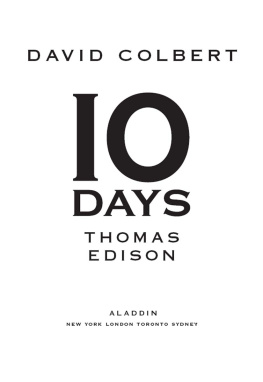
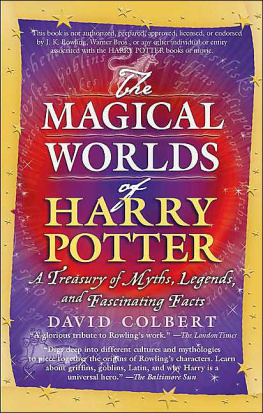
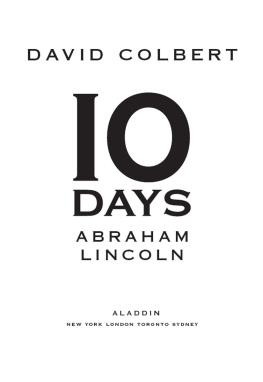
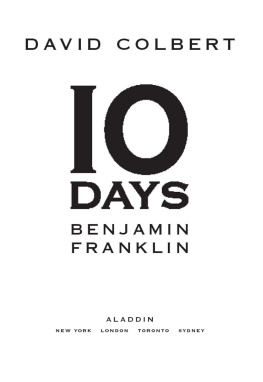

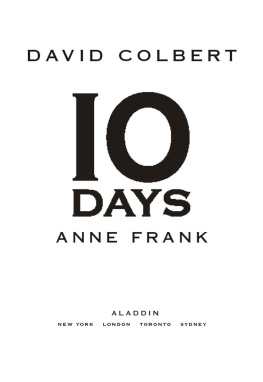

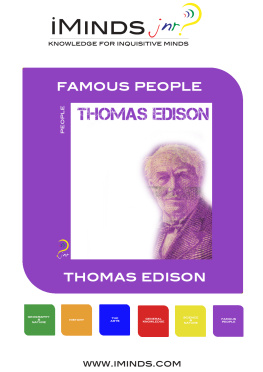
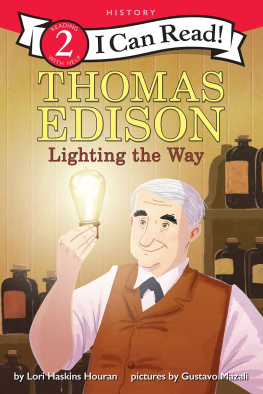

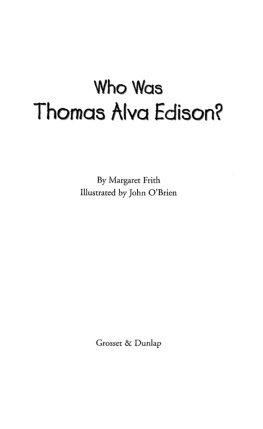
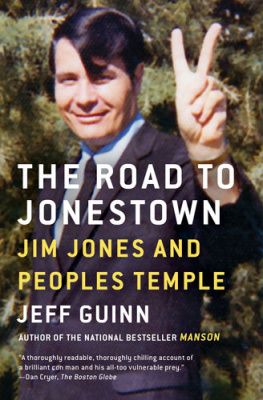
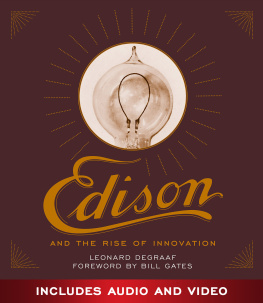
 ALADDIN An imprint of Simon & Schuster Childrens Publishing Division 1230 Avenue of the Americas, New York, NY 10020 Copyright 2008 by David Colbert All rights reserved, including the right of reproduction in whole or in part in any form. ALADDIN and related logo are registered trademarks of Simon & Schuster, Inc. Special thanks to Paul Gasbarra and Jesse Waters for their significant contributions to this book, and to John Chew for his mathematical expertise. Library of Congress Control Number 2008920646 ISBN-13: 978-1-4169-9890-7 ISBN-10: 1-4169-9890-X
ALADDIN An imprint of Simon & Schuster Childrens Publishing Division 1230 Avenue of the Americas, New York, NY 10020 Copyright 2008 by David Colbert All rights reserved, including the right of reproduction in whole or in part in any form. ALADDIN and related logo are registered trademarks of Simon & Schuster, Inc. Special thanks to Paul Gasbarra and Jesse Waters for their significant contributions to this book, and to John Chew for his mathematical expertise. Library of Congress Control Number 2008920646 ISBN-13: 978-1-4169-9890-7 ISBN-10: 1-4169-9890-X










